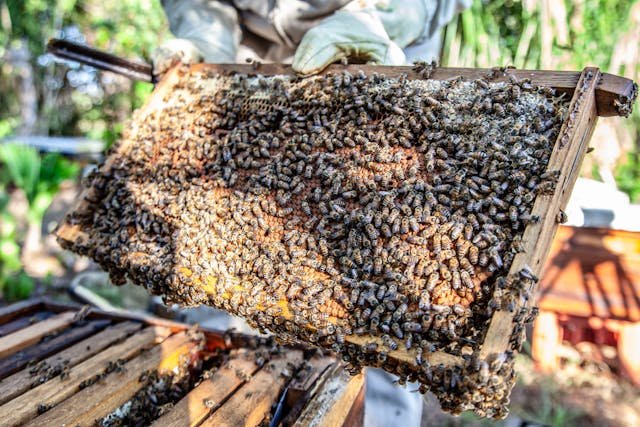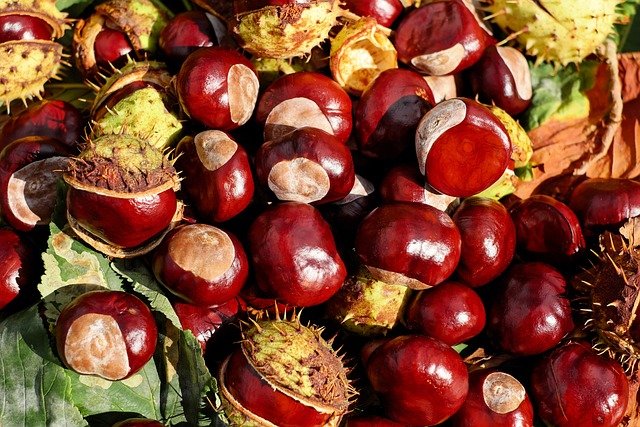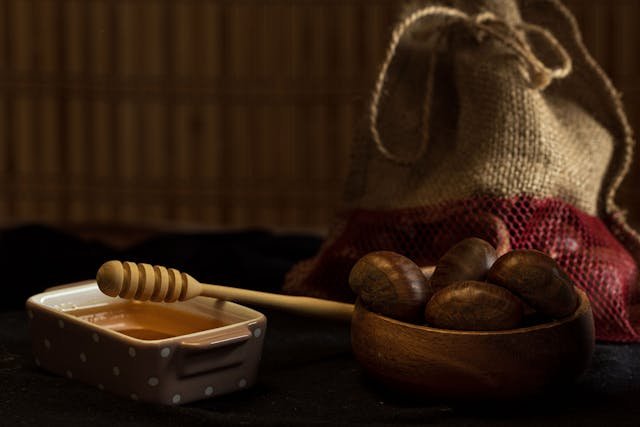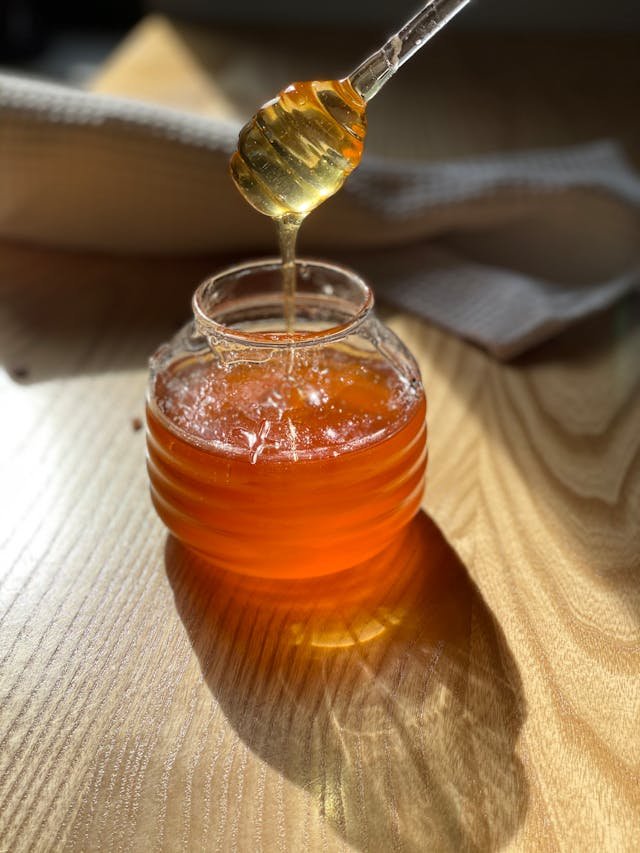Chestnut honey is a special type of honey with a rich flavor and deep color. It comes from the nectar of chestnut tree flowers. This honey is different from others because of its different taste and health benefits. Chestnut honey is especially famous in Italy, but it is also produced in France and Greece. Each region gives the honey its own unique flavor.
In this article, we will explore what makes chestnut honey unique, how it is made, and how you can enjoy it.
What Is Chestnut Honey?
- Definition: Chestnut honey is a type of honey made from the nectar of chestnut tree flowers. The chestnut tree, or Castanea, has flowers that bees visit for nectar. This nectar is then transformed by the bees into honey. Unlike clover or wildflower honey, chestnut honey comes from the chestnut tree.
- Color: One of the most noticeable characteristics of chestnut honey is its color. It ranges from dark amber to almost black. This dark color comes from the high mineral content in the nectar of chestnut flowers. The rich hue is a visual indicator of the honey’s robust flavor and nutritional density.
- Taste: Chestnut honey has a unique taste. It is very different from lighter, milder honeys. It is bold and robust, with a slightly bitter undertone. Some say it has hints of caramel or molasses, with a lingering aftertaste. Its strong flavor makes chestnut honey a favorite. It suits those who prefer intense, less-sweet honey.
- Aroma: Chestnut honey also has a distinct aroma. It often smells earthy and woody, with subtle notes of chestnut blossoms. This aromatic profile adds to the sensory experience of tasting chestnut honey.
- Texture: Chestnut honey’s texture can vary. But, it is generally thicker than lighter honeys. It can be smooth and slightly viscous, making it easy to spread on bread or drizzle over food.
- Nutritional Content: Chestnut honey is rich in antioxidants, vitamins, and minerals. It contains high levels of potassium, calcium, and magnesium. These nutrients provide health benefits. They boost the immune system, aid digestion, and fight bacteria.The source of nectar is crucial to chestnut honey’s traits. The chestnut tree flowers bloom in late spring to early summer. They provide bees with a rich nectar source during this time. Chestnut honey’s quality and flavor can vary. They depend on the type of chestnut tree and its environment.
- Varietal Differences: All chestnut honey comes from chestnut tree flowers. But it can vary by the tree’s species. European chestnut trees (Castanea sativa) are the main source of chestnut honey in Europe. In parts of Asia, chestnut honey may come from different species, like the Japanese chestnut (Castanea crenata).
Chestnut honey is not only a delicious treat but also a nutritional powerhouse. Its unique flavor, dark color, and health benefits make it a standout among other types of honey. Chestnut honey is delicious. You can drizzle it over yogurt, spread it on toast, or use it in cooking. It is rich and flavorful. It is both delicious and healthy for you.
Country of Origin
- Italy: Chestnut honey is especially famous in Italy. The regions of Tuscany and Piedmont are well-known for producing high-quality chestnut honey. The chestnut trees in these areas provide the nectar that gives the honey its distinctive flavor. Italian chestnut honey is known for its bold taste and rich aroma. Italy has beekeeping traditions passed down through generations. They keep the honey pure and of high quality.
- France: Chestnut honey is mainly made in Corsica and Provence. The French variety is often described as having a slightly milder taste compared to Italian chestnut honey. However, it still retains the robust and earthy notes that make chestnut honey unique. French beekeepers use traditional methods to produce honey. This keeps it free from additives and natural.
- Greece: also produces chestnut honey. It is best in regions with many chestnut trees, like Thessaly and Macedonia. Greek chestnut honey is known for its intense flavor and dark color. It is often harvested from wild chestnut forests. This gives it a distinct, natural taste. Greek beekeepers take great care in harvesting and processing the honey to maintain its quality and health benefits.
Other Regions: Italy, France, and Greece are the top chestnut honey producers. Other countries with chestnut trees also produce it. Countries like Spain and Switzerland have regions with chestnut trees. They provide the nectar for chestnut honey. Each country’s chestnut honey has a unique flavor. It depends on the local chestnut trees and climate.
How is Chestnut Honey made?

Making chestnut honey is a fascinating journey. It involves the hard work of bees and the expertise of beekeepers. Here’s a detailed look at how chestnut honey is made:
- Bees and Nectar Collection
Nectar Gathering: It starts with bees collecting nectar from chestnut tree flowers. Chestnut trees bloom in late spring and early summer, providing a rich source of nectar for the bees. The bees use their long proboscis to suck the nectar from the flowers.
Enzymatic Transformation: The bees collect nectar and store it in their honey stomachs. When inside this honey stomach, enzymes mix with the nectar. They begin to turn it into honey.
- Honey Production in the Hive
Regurgitation and Storage: After collecting the nectar, the bees return to the hive. They regurgitate the nectar into the mouths of worker bees, who further chew it to add more enzymes. This process helps to break down the complex sugars in the nectar into simpler sugars.
Evaporation and Thickening: The chewed nectar is then deposited into honeycomb cells. Bees fan their wings to thicken the nectar. This reduces its water content by creating airflow in the hive. This evaporation process is crucial to turning the nectar into honey. The honey becomes thicker and more concentrated as the water evaporates.
- Capping the Honey
Sealing the Honeycomb: When the honey is perfect, the bees cap the cells with beeswax. This capping process preserves the honey. It protects it from moisture and contaminants.
Ripening: The honey is allowed to ripen in the sealed cells. During this time, it continues to develop its flavor and nutritional properties.
- Harvesting the Honey
Beekeeper’s Role: Beekeepers play a crucial role in harvesting chestnut honey. They patiently remove the honeycomb frames from the hive. They avoid disturbing the bees too much.
Extraction: The frames are then taken to a honey extraction facility. The beeswax caps are removed. Then, honey is extracted from the comb using a centrifugal force in a honey extractor.
Filtering and Bottling: After extraction, the honey is filtered to remove any bits of wax and impurities. The pure chestnut honey is then bottled and ready for consumption.
Why Is Chestnut Honey Special?

Chestnut honey is a favorite among honey lovers for several reasons. Let’s delve into what makes it unique and special.
- Unique Flavor: Chestnut honey is renowned for its bold and robust taste. Unlike lighter, sweeter honeys, it has a slightly bitter taste. It has hints of caramel and molasses. This distinctive flavor profile comes from the nectar of chestnut tree flowers. The taste can vary slightly by region, where the chestnut trees grow. But, it always has a rich, complex flavor that lingers on the palate. For those who enjoy a more intense and less sweet honey, chestnut honey is an excellent choice.
- Health Benefits: Chestnut honey is tasty and very healthy. It has antioxidants. They protect the body from free radicals. They also reduce the risk of chronic diseases. This honey also has high levels of minerals. They include potassium, calcium, and magnesium. They are essential for good health. Chestnut honey can help heal wounds. Its antibacterial properties boost the immune system. It also has prebiotic qualities. They promote gut health by boosting good bacteria.
- Uses: The versatility of chestnut honey makes it special. Its strong flavor pairs well with a variety of foods and can be used in both sweet and savory dishes. It pairs well with cheeses, especially strong ones like blue cheese or aged cheddar. Chestnut honey can be drizzled over yogurt, added to teas, or used as a natural sweetener in baking. Its robust flavor makes it great for marinades, dressings, and sauces. It adds depth and speciality to recipes.
- Nutritional Content: Chestnut honey has antioxidants, minerals, and B vitamins. They are vital for energy and health. It contains amino acids that play a role in protein synthesis and repair of body tissues. The combination of these nutrients makes chestnut honey a powerhouse of health benefits.
- Natural and Pure: Chestnut honey is often made using traditional beekeeping methods. These methods focus on the honey’s purity and natural qualities. Beekeepers in Italy, France, and Greece are known for their chestnut honey. They take great care to ensure their honey is pure. It must have no additives or contaminants. This dedication to quality yields a product as close to its natural state as possible. It retains all the beneficial properties that make it special.
- Aroma and Appearance: The aroma of chestnut honey is another aspect that sets it apart. It has an earthy, woody scent with subtle floral notes. It is reminiscent of the chestnut blossoms from which it is derived. This unique aroma adds to the overall sensory experience of consuming chestnut honey. Its color, dark amber to nearly black, shows its rich flavor and high mineral content. The dark color comes from pollen and other natural components. They reflect its purity and richness.
- Cultural Significance: In many regions, chestnut honey is more than a sweet treat. It is part of a cultural heritage. In Italy, chestnut honey has been made for centuries. It is a key part of culinary traditions. The use of chestnut honey in local recipes shows its importance. Its sale at markets and festivals does too. This cultural significance gives each jar of chestnut honey a rich history.
Chestnut honey is special. It has a unique flavor. It has health benefits, too. It’s versatile and nutritious. It’s also pure and aromatic. Plus, it has cultural significance. Chestnut honey is a must-try. It has a rich, unique flavor. It has more uniqueness than other types of honey.
How to Enjoy Chestnut Honey
Chestnut honey is versatile and can be enjoyed in many different ways. Here are some suggestions on how to incorporate this unique honey into your diet:
In Recipes
- Baking: Chestnut honey adds a rich flavor to baked goods. Use it as a sweetener in pastries, cookies, and muffins. Its bold taste pairs well with spices like cinnamon and nutmeg.
- Sauces and Dressings: Incorporate chestnut honey into sauces and salad dressings. It adds depth and complexity, making it perfect for vinaigrette or marinades.
- Glazes: Create a glaze for roasted meats or vegetables. Mix chestnut honey with soy sauce, garlic, and a splash of vinegar for a delicious glaze.
- Beverages: Sweeten your tea or coffee with chestnut honey. Its unique flavor adds a special touch to your morning drink. You can also use it in smoothies for a hint of sweetness and added nutrition.
With Food
- Cheese Pairing: Chestnut honey pairs wonderfully with cheese. Drizzle it over strong cheeses like blue cheese, aged cheddar, or gouda. The honey’s strong flavor complements the rich cheese. It creates a tasty contrast.
- Breakfast: Add chestnut honey to your breakfast routine. Drizzle it over yogurt, oatmeal, or pancakes for a nutritious and flavorful start to your day. Its strong flavor pairs well with fruits and nuts, enhancing the overall taste.
- Snacks: Use chestnut honey as a dip for fresh fruits like apples, pears, and figs. It is also used on toast or crackers. Combine it with nut butter for a delicious and satisfying snack.
As a Spread
- Bread and Toast: Spread chestnut honey on warm bread or toast. Its thick texture and rich flavor make it an excellent alternative to jam or butter. You can also add a sprinkle of sea salt for a mouthwatering and salty combination.
- Pancakes and Waffles: Drizzle chestnut honey over pancakes or waffles. Its unique taste adds a special touch to these breakfast classics. Pair it with fresh berries or whipped cream for an indulgent treat.
- Crepes: Use chestnut honey as a filling for crepes. Spread it inside the crepe with sliced bananas or strawberries. It’s a delicious dessert or breakfast.
In Cooking
- Marinades: Chestnut honey works well in marinades for meats. Mix it with olive oil, garlic, and herbs to create a flavorful marinade for chicken, pork, or beef. The honey helps to tenderize the meat while adding a rich, caramelized flavor.
- Roasted Vegetables: Toss carrots, sweet potatoes, and Brussels sprouts with chestnut honey. Then, roast them. The honey caramelizes in the oven, giving the vegetables a sweet and savory glaze.
- Dressings: Make a simple salad dressing with chestnut honey. Mix it with olive oil, mustard, and vinegar. You’ll get a tangy, sweet dressing. It mix well with greens, nuts, and cheese.
As a Natural Sweetener
- Tea and Coffee: Replace sugar with chestnut honey in your tea or coffee. It dissolves easily and adds a distinctive flavor. This natural sweetener is a outstanding alternative to refined sugar.
- Smoothies: Add a spoonful of chestnut honey to your smoothie. It goes well with fruits, yogurt, and milk. It enhances the flavor and adds health benefits.
Health and Wellness
- Natural Remedy: Chestnut honey has antibacterial and anti-inflammatory properties. Use it as a natural relief for sore throats and coughs. Mix it with warm water and lemon for a soothing drink.
- Skin Care: Apply chestnut honey topically to your skin. Its moisturizing and healing properties can help with minor cuts, burns, and dry skin. Use it as a face mask by mixing it with yogurt or oatmeal for a natural glow.
Special Occasions
- Gift Giving: Chestnut honey makes a thoughtful and unique gift. Present it in a decorative jar with a ribbon. It’s a perfect gift for food enthusiasts and honey lovers.
- Festive Dishes: Incorporate chestnut honey into festive dishes. Use it in holiday baking or as a glaze for roasted meats during special occasions.
Exploring New Flavors
- Experimentation: Don’t be afraid to experiment with chestnut honey in your cooking. Its strong flavor can enhance a variety of dishes. Try new recipes and combos. You may find your favorite ways to enjoy this special honey.
Chestnut honey is a versatile, tasty ingredient. It can enhance many dishes and snacks. Its unique flavor and health benefits make it a valuable addition to your pantry. Enjoy experimenting with chestnut honey. Find new ways to use it in your diet!
Where to Buy Chestnut Honey

Finding high-quality chestnut honey can be a rewarding experience. Here are some tips on where to buy chestnut honey:
Local Farmers’ Markets
- Fresh and Local: You can find chestnut honey at farmers’ markets. Local beekeepers sell it there. Buying locally ensures that the honey is fresh and supports small-scale beekeepers.
- Meet the Beekeepers: At farmers’ markets, you can often meet the beekeepers. You can ask them about their beekeeping and the honey’s origin. You can also taste samples before buying.
Specialty Food Stores
- Gourmet Selections: Specialty food stores often sell a range of high-quality honeys. This includes chestnut honey. These stores sell gourmet and artisanal products. They have a curated selection of unique, premium items.
- Specialty store staff can recommend and inform you about their honey. This helps you make an informed choice.
Online Retailers
- Convenience: Online shopping offers convenience and a wide range of options. Many websites sell honey and bee products. So, it’s easy to find chestnut honey from various regions.
- Customer Reviews: Online retailers often have customer reviews. They can help you judge the honey’s quality and taste before buying. Look for highly rated products and read feedback from other buyers.
Health Food Stores
- Natural Products: Health food stores usually stock natural and organic items, including honey. They may offer chestnut honey that is free from additives and pesticides.
- Organic Options: If you prefer organic honey, health food stores are a good place to look. They often carry chestnut honey, certified organic. It meets strict standards.
Beekeeping Associations and Co-ops
- Direct from Beekeepers: Beekeeping associations and cooperatives often sell honey directly to consumers. This can be a great way to support beekeepers. It will ensure you get authentic, high-quality chestnut honey.
- Educational Resources: They may provide materials on beekeeping and honey production. This can improve your knowledge and appreciation of the product.
European Imports
- For real European chestnut honey, check import stores or sites that sell European foods. These retailers often carry honeys from famous honey-producing countries: Italy, France, and Greece.
- Regional Specialties: European import stores can provide regional specialties. They offer chestnut honey that reflects its unique place of origin.
Local Beekeeping Clubs
- Community Connections: A local beekeeping club may connect you with beekeepers who sell honey. Clubs often have members who produce and sell honey, including chestnut honey.
- Beekeeping clubs may host events or markets to sell honey. These events are a great chance to buy fresh, local chestnut honey.
Tips for Buying Chestnut Honey
- Check Labels: When buying chestnut honey, check the label. It should show its origin, how it was made, and any certifications, like organic or fair trade.
- Look for Raw Honey: Raw chestnut honey is less processed. It retains more natural nutrients and enzymes. Look for labels in the bottle or packet that indicate the honey is raw.
- Verify Authenticity: Be cautious of counterfeit products. Authentic chestnut honey should have a distinct flavor and color. Purchase from reputable sources to ensure you are getting genuine chestnut honey.
- Consider the Packaging: Glass jars are better than plastic for honey. Glass does not leach chemicals and preserves honey’s flavor and quality.
- Taste Test: If possible, taste the honey before buying. This can give you an idea of its flavor profile and help you determine if it matches your preference.
Finding high-quality chestnut honey can be easy when you know where to look. You can buy from local markets, specialty stores, or online retailers. There are many options to explore. Enjoy the rich, robust flavor of chestnut honey in your culinary creations!
Frequently Asked Questions
- What Makes Chestnut Honey Different? Chestnut honey is unique due to its dark color and strong flavor. It comes from chestnut flowers, unlike lighter, milder honeys.
- Is Chestnut Honey Good for You? Yes, it is full of antioxidants and can help with digestion. It also has a distinctive taste that many people enjoy.
- Can You Use Chestnut Honey in Cooking? Absolutely! It is really enjoyable in both sweet and savory dishes. It adds a rich flavor to many recipes.
Conclusion
Chestnut honey is a special honey with a rich taste and many benefits. It comes from chestnut tree flowers and has a unique flavor that sets it apart from other types of honey. Whether you use it in cooking or enjoy it on its own, chestnut honey offers a delicious and healthy option for honey lovers.



